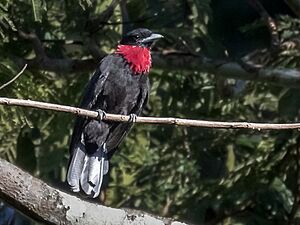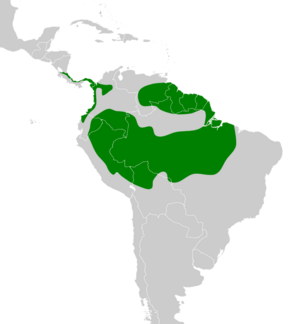Purple-throated fruitcrow facts for kids
Quick facts for kids Purple-throated fruitcrow |
|
|---|---|
 |
|
| Male | |
| Conservation status | |
| Scientific classification | |
| Genus: |
Querula
|
| Species: |
purpurata
|
 |
|
The purple-throated fruitcrow (Querula purpurata) is a cool species of bird from the Cotingidae family. It's the only bird in its special group, called Querula. This bird lives in countries like Nicaragua, Costa Rica, Panama, and much of northern South America. It loves humid lowland forests, which are warm and wet.
This fruitcrow is a shiny black bird of medium size. Male birds have a special purple-red patch on their throat. They like to build their nests close to other fruitcrows. Even though their numbers are slowly going down, there are still many of these birds. Because of this, the International Union for Conservation of Nature says it's a "least concern" species. This means it's not in danger right now.
What Does the Purple-Throated Fruitcrow Look Like?
The purple-throated fruitcrow is a strong, medium-sized bird. It has shiny black feathers all over its body. Male fruitcrows have a big, bright purple-red patch on their upper throat. This patch also goes a little bit down the sides of their neck. It looks a bit like the colorful throat of a hummingbird.
This bird has a short, wide bill that is grayish in color. Its eyes are black, and its legs are gray.
Where Does the Purple-Throated Fruitcrow Live?
You can find the purple-throated fruitcrow in many countries. These include Bolivia, Brazil, Colombia, Ecuador, French Guiana, Guyana, Peru, Suriname, and Venezuela. It also lives in southern Central America, in Nicaragua, Costa Rica, and Panama.
This bird's favorite habitat is subtropical or tropical moist lowland forests. These are forests that are warm and wet, close to the ground. The purple-throated fruitcrow lives across northern South America. Some groups of these birds live west of the Andes mountains and reach into Central America. They can be found from the Guianas and eastern Brazil all the way across the Amazon basin to the Andes mountains.
Even though their numbers are slowly decreasing, there are still many of these birds. They live in a very large area. Because of this, the International Union for Conservation of Nature says they are a "least concern" species. This means they are not currently in danger.
How Does the Purple-Throated Fruitcrow Behave?
Even though it's called a "fruitcrow," this bird eats more than just fruit! The purple-throated fruitcrow also eats many different kinds of insects. They move through the tops of the forest trees in small groups. As they move, they often make chattering sounds.
These birds also like to build their nests close to each other. They nest in groups, which is called nesting colonially. They don't try very hard to hide their nests. In fact, the nests become even more noticeable because of the noisy group of birds nearby!


